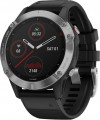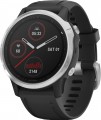Size
The size of the display installed in the gadget; for round screens, respectively, the diameter is indicated.
A larger screen, on the one hand, is more convenient to use, on the other hand, it significantly affects the dimensions of the entire device, which is especially critical for wearable gadgets. Therefore, manufacturers choose the display size in accordance with the purpose and functionality of each specific model — so that there is enough space on the screen and the device itself is not too bulky.
It is also worth mentioning that screens with a similar size may have different aspect ratios. For example, traditional smartwatches are usually equipped with square or round panels, while in fitness trackers, screens are often made elongated in height.
Screen resolution
Screen size in dots (pixels) horizontally and vertically. In general, this is one of the indicators that determine the image quality: the higher the resolution, the clearer and smoother the picture on the screen (with the same size), the less noticeable are the individual dots. On the other hand, an increase in the number of pixels affects the cost of displays, their power consumption and requirements for a hardware platform (more powerful hardware is required, which itself will cost more). In addition, the specifics of using smartwatches is such that there is simply no need to install high-resolution screens in them. Therefore, modern wrist accessories use displays with a relatively low resolution: for example, 320x320 with a size of about 1.6" is considered quite sufficient even for premium watches.
Memory storage
The amount of own storage provided in the design of the watch/bracelet. This memory is used for permanent storage of various information: call log, received SMS and other messages, additional applications, data on physical activity for a certain time, etc. The larger its volume, the more data can be stored in the device without the need to clean it to free up space. On the other hand, in the operation of smartwatches, large volumes (
64 GB,
32 GB,
16 GB, even
8 GB and
4 GB) are not always required, capacious drives are quite expensive, and replaceable cards installed in corresponding slot (see below).
Operating time (normal mode)
The time that the gadget can work on one battery charge (or the supplied battery) in normal use.
Normal mode, as a rule, means working with a relatively low load. At this time, the display can display some data, and basic functions can also work (counting steps, periodically checking heart rate, etc.), but in any case, power consumption is low. Therefore, the operating time in normal mode can be quite impressive, up to
several weeks, or even months. However, when choosing, it doesn’t hurt to also pay attention to the stated time in active mode (see below) — especially if a long operating time is critical, or you plan to use the gadget intensively. The actual autonomy of the device will most likely be somewhere in between these two values, depending on the actual load. If only the time in normal mode is indicated for the gadget, you should choose with a certain reserve.
Operating time (active mode)
The time that the gadget is able to work on one charge of the battery in the active mode of use.
For watch-phones (see “Type”), this usually means a talk mode, for other gadgets, an intensive work mode when numerous features and sensors are used and there is a constant exchange of data with a smartphone/tablet. However, the specific understanding of the "active mode" for different manufacturers may vary: some indicate the time at maximum performance (that is, in fact, guaranteed battery life), others — in some kind of "average mode". However, anyway, this is a fairly clear parameter that describes the battery life of a particular model quite well (and is much closer to real indicators than the time in normal mode mentioned above).
Note that for models with a GPS sensor (see "Navigation"), the specifications may additionally specify the time of active operation using such a sensor. See "Operating time (GPS)" for details.
Battery life (GPS)
The time that the gadget is able to work on one charge of the battery (or supplied battery) when using a GPS sensor.
This parameter is specified mainly for high-end tourist watches designed for experienced travelers, military, rescuers, divers, pilots, etc. Such devices use advanced GPS receivers, which themselves can consume quite a significant amount of energy; in addition, the operation of the receiver is inevitably accompanied by the use of other features — transferring navigation data to another device (usually via Bluetooth), working with its own built-in maps, etc. Therefore, the battery life while using GPS turns out to be rather modest — it can be significantly less time in active and even less in normal mode (for both, see above).
We also remind that the battery life mentioned in specs is approximate — in fact it may differ (in one direction or another, depending on the use scenario). Nevertheless, it is quite possible to evaluate the actual capabilities of the watch and compare them with each other: the difference in the claimed battery life usually proportionally corresponds to the difference in practical battery life.
Bezel
Swivel ring around the round dial of the smartwatch.
Bezel exists for a decorative and protective purpose, and in many models it has additional markings and provides a number of special control options. By rotating it, you can navigate through the menu of the smartwatch, and it also simplifies interaction with the touch screen of the wearable device. On the bezel, special marks are often applied for the operation of the watch dial in the timer or stopwatch mode. The specific implementation of the features assigned to the ring depends on the specific model of smartwatch.
— Metallic. The metal bezel has high mechanical strength. Usually it is made of stainless steel.
— Plastic. A low cost version of the bezel, which is found in smartwatch models with plastic cases.
Band Width
The width of the stock watch strap or bracelet is implied. Usually, in each specific model taken, this value is limited by the size of the standard lugs. A wider strap than the lugs allow cannot be installed. But the strap of a smaller width is quite possible to use. Of course, you need to take into account that an overly thin strap with a large diameter watch will not look quite harmonious. Most often, the width of the strap is directly related to the diameter of the dial. As a standard, the width is calculated using the formula: ½ x D, where D is the diameter of the dial. That is, if the dial diameter is 40 mm, then the perfect strap width in this case is 20 mm.
Wrist strap
Wrist coverage suitable for the included watch strap. Usually, the length of the strap can be adjusted, so this paragraph usually indicates not one number, but a range — for example, "130 – 200" (millimetres). If there are several straps in the kit, then several ranges are indicated in the specs, if necessary, with a clarification like “fabric: 115 – 185, metal: 130 – 220” (if the straps are made of different materials).
We emphasize that in this case we are talking not just about the length of the strap, but about the girth of the wrist, for which it is designed. Thus, by measuring your hand in an appropriate way, you can accurately determine whether a particular strap is suitable for a particular person or not. This possibility is especially important if the watch is bought for a user with a non-standard hand size — miniature or, conversely, very large.

